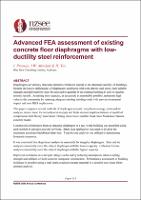Advanced FEA assessment of existing concrete floor diaphragms with low-ductility steel reinforcement

Download
Date
2020-04-22Authors
Prionas, Ioannis
Mitchell, John
Tan, Haozhi
Metadata
Show full item recordAbstract
Diaphragms are primary structural elements which are crucial to the structural stability of buildings. Despite the known deficiencies of diaphragms reinforced with cold-drawn steel mesh, their reliable strength and deformability must be assessed to quantify if the existing building is safe or requires seismic retrofit. Assessing their capacity, as accurately as reasonably possible, represents high value to the community by retaining adequate existing building stock with zero environmental impact and zero H&S implications.
This paper compares several methods of diaphragm analysis: deep beam analogy, strut-and-tie analysis, elastic shear friction/cohesion analysis and finite element implementations of modified compression field theory: total strain rotating crack model and the fixed crack Maekawa-Fukuura concrete model.
Construction information from an irregular diaphragm in a real-world building was modelled using each method in advance analysis software. Static load application was used to develop the maximum envelope (backbone) behaviour. Time-history analysis was utilised to demonstrate hysteretic responses.
It was concluded that deep beam analysis is unsuitable for irregular diaphragms. Strut and tie analysis consistently rated the subject diaphragm with the lowest capacity. Cohesion friction analysis consistently rated the subject diaphragm with the highest capacity.
Improved confidence in a strength rating is achieved by reducing assumptions when coupling strength and stiffness of steel-concrete composite construction. Performance assessment of building resilience is possible using a total strain cracked concrete material in a detailed non-linear finite-element analysis.
